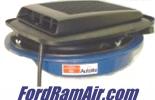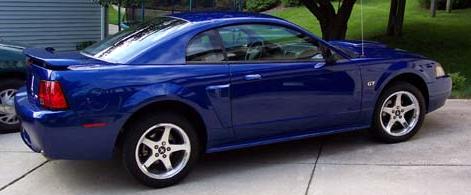It took me a few try's, but I finally found this site again. http://www.flatratetech.com/The owner has moved it from the previous web host since I last visited his site, so the address changed. He now has it in UBB format.
I found the original site a right after he started it. Lots of good info and insight into the workings of Ford and Ford tech's. The guy has a lot of good knowledge.
This should help you.
--------------------------
http://flatratetech.com/pub34.
Deciphering OBD-II Codes FRT
Published by: Flatratetech.com
Publishing Date: 11.3.2001
Authored by: Terry Ogilvie
Enhanced OBD-II refers to information that is specific to a particular vehicle or vehicle manufacturer that is available in addition to generic OBD-II information. How enhanced OBD-II data is defined and presented varies not only by make, but can also vary by model, year, or engine application for the same manufacturer.
Enhanced OBD-II must follow structural guidelines to a point, but a considerable amount of leeway is permitted so it can be tailored to a specific application. Typically, enhanced OBD-II provides more detailed information, so it is a more valuable diagnostic tool. Guidelines for OBD-II were established by the Society of Automotive Engineers (SAE) with the cooperation of various vehicle manufacturers.
The U.S. Government adopted the SAE guidelines into law, and several other countries followed suit. The SAE maintains control of the established OBD-II guidelines, which are revised and updated periodically. With the difference between generic and enhanced in mind, consider how all OBD-II diagnostic trouble codes are structured. Any DTC must display in a five character alpha-numeric format.
First Character
The first character, a letter, identifies which control system set the code. The other four characters, all numbers, provide additional information on where the DTC originated and the operating conditions that caused it to set. First Character Four letters are currently assigned for use as the first character of a DTC:
P = Powertrain
B = Body
C = Chassis
U = Undefined
Powertrain ("P") codes, apply to the engine along with its emission control systems and the transmission. These codes are generated by either the powertrain control module (PCM), engine control module (ECM), or transmission control module (TCM).
Body ("B") codes, are set by the body control module (BCM) and pertain to climate control, lighting, and electronically regulated power accessory systems.
Chassis ("C") codes define problems in the traction control, variable assist steering, automatic load leveling, and other systems that regulate vehicle dynamics.
Undefined codes are not presently used.
Second Character
The second character The second character of an OBD-II code is a number, and currently zero through three are used. With any type of DTC (P, B, C or U) a zero in the second position indicates a generic, or SAE defined, code. The number one in this position indicates an enhanced OBD-II code, or a code defined by the Original Equipment Manufacturer (OEM). When a two or three appears as the second character, the meaning varies according to the system (P, B, C, or U) . With powertrain codes, both numbers are reserved by SAE for future use. With Body or Chassis codes, "2" is reserved for OEM use and "3" is reserved for SAE assignment.
Third Character
The third character of a DTC indicates the system or sub-system where the fault occurred. For powertrain codes:
1 = Fuel or Air Metering
2 = Fuel or Air Metering
3 = Ignition or Engine Misfire
4 = Auxiliary Emission Controls
5 = Vehicle or Idle Speed Controls
6 = Computer or Output Circuit
7 = Transmission Controls
8 = Transmission Controls
9 = SAE Reserved for future use
0 = SAE Reserved for future use
For example:
P01xx = Powertrain, Generic, Fuel or Air Metering Fault
P11xx = Powertrain, Enhanced, Fuel or Air Metering Fault
Fourth and Fifth Characters
The fourth and fifth characters, indicate the operating conditions that triggered the code. Sensors, actuators and circuits are assigned blocks of numbers. The lowest numbers in a block ("00") indicate general malfunctions. Higher numbers provide more specific code setting information, such as low or high signal voltage, a slow response, or an out-of-range signal. For example,
DTC P0100 indicates:
P = Powertrain
0 = Generic
1 = Fuel or Air Metering Fault
00 = General circuit malfunction
 Graphics by: Joe M. Young
Graphics by: Joe M. Young
1.) Many driveability concerns are quickly identified using DTCs.
2.) DTCs beginning with "P0" are Generic and their definition is the same for any vehicle. Enhanced DTCs begin with "P1" and their definition is unique to that particular vehicle.
3.) Some DTCs are the result of an open or short circuit and do not set if the signal is simply out of range.
Others set only if the range or performance is outside the limits of a pre-determined tolerance.
4.) When an OBDII failure is detected, the Malfunction Indicator Lamp (MIL) lights and remains on even if the condition is intermittent. However, some DTCs have two-trip logic, which means the fault must be recognized on two consecutive trips before the DTC sets and the MIL lights. Acura and Honda use three-trip logic for some DTCs, so the conditions must occur on three consecutive trips before the code sets. Also, if the fault does not recur within three or more sequential drive cycles after a DTC is set, the PCM may switch off the MIL. However, the DTC will remain in PCM memory until it is cleared.
5.) Most DTCs are held in memory until they are cleared using a Scan tool. Note, this may include DTCs that are in memory but are not designed to light the MIL.
6.) Be aware, some previously repaired faults may have stored DTCs in PCM memory, but may not have been cleared properly. Always document any DTCs before clearing them. On most vehicles if no DTCs are present, code P0000 (pass code) displays. To verify that a problem area has been repaired, it may be necessary to operate the vehicle through a specific drive cycle and recheck for codes. Remember two-trip DTCs take two drive cycles before they set, so two test drives may be needed to ensure the problem is corrected. A good method of verifying repairs is to use the Scan tool to check the OBD-II monitor status after road testing. Providing the test drive meets the OBD-II drive cycle criteria for that vehicle, the monitor for that system will read "Not Ready" if there is a pending code. This indicates the DTC setting the conditions occurred on the first trip. If all of the monitors read "Ready", the problem was repaired.
----------------------
Hope that helps!
Stewart
[This message has been edited by Stewart (edited 11-05-2001).]











 Mustangsandmore Forums
Mustangsandmore Forums

 '94 to '03 -- The SN95 Mustang
'94 to '03 -- The SN95 Mustang

 OBD II Trouble Codes
OBD II Trouble Codes


